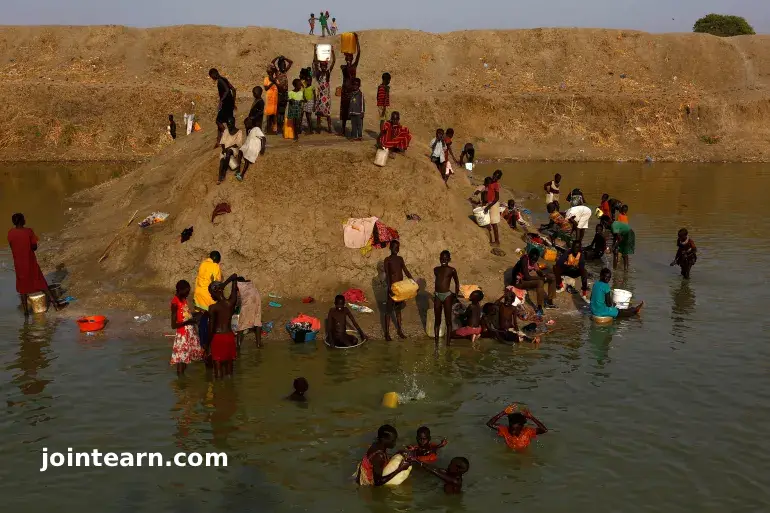
A shocking new report reveals that nearly two-thirds of children in South Sudan are engaged in dangerous and exploitative labour, making it one of the highest child labour rates in the world.
According to the National Child Labour Study, released jointly by the South Sudanese government and Save the Children, approximately 64 percent of children aged 5 to 17 are working under conditions that violate international child protection laws. In some areas, that figure soars to as high as 90 percent.
A Nationwide Crisis Driven by Conflict, Flooding, and Hunger
Researchers say the child labour epidemic in South Sudan is the result of decades of conflict, severe flooding, disease outbreaks, and widespread poverty that have left families with few survival options.
In Kapoeta South, near the Ugandan border, nine out of ten children reportedly work in gold mining, herding, and farming rather than attending school. Similarly, the Yambio region in the southwest has seen a spike in child marriage and domestic labour as conflict forces families deeper into crisis.
“This is a crisis that goes beyond poverty,” said Chris Nyamandi, Save the Children’s Country Director for South Sudan. “When nearly two-thirds of a nation’s children are forced into work — and in some areas, almost every child — it reflects the collapse of social protection systems.”
Forms of Child Exploitation and Gender Divide
The report found that 10 percent of children surveyed had been recruited or coerced into armed groups, particularly in conflict-heavy areas such as Akobo, Bentiu, and Kapoeta South.
- Boys are more likely to be drawn into military recruitment, mining, and construction work, all of which expose them to injury and exploitation.
- Girls disproportionately face forced marriage, sexual violence, and domestic servitude, often beginning as young as age 10.
“Education remains the strongest protective factor,” Nyamandi added. “Children who stay in school are far less likely to be forced into labour or early marriage.”
Knowledge of the Law Fails to Stop Exploitation
Surprisingly, the study showed that 70 percent of families with children in illegal or dangerous work were aware of child protection laws — but lacked the means to act on them.
Two-thirds of children surveyed did not know that legal or social support existed to help them escape exploitation. Researchers say this highlights the gap between legislation and enforcement in South Sudan.
Government Acknowledges ‘Critical’ Findings
At the report’s launch in Juba, Deng Tong, the undersecretary at the Ministry of Labour, admitted that the findings expose a nationwide emergency:
“This report provides a critical foundation for government action. We must strengthen laws, expand education access, and protect our children from exploitation.”
The South Sudanese government pledged to work with Save the Children, UNICEF, and other partners to develop a national action plan addressing forced labour and child exploitation.
Flooding, Disease, and Hunger Deepen the Child Labour Crisis
The child labour crisis is unfolding alongside one of the worst humanitarian emergencies South Sudan has faced in years.
Nearly one million people have been affected by severe flooding, with more than 335,000 displaced and 140 health facilities destroyed or submerged, according to the United Nations.
At the same time, the country is experiencing a malaria outbreak, with over 104,000 cases reported in the past week, and 7.7 million people suffering from acute hunger.
Climate change is worsening these conditions, driving families into child labour as a survival strategy.
Conflict and Political Instability Fuel Exploitation
The report comes amid rising political tension in South Sudan. The fragile 2018 peace agreement between President Salva Kiir and First Vice President Riek Machar is increasingly strained, with armed clashes intensifying across several states.
Machar’s arrest and ongoing treason trial have further destabilized the country. UN investigators warn that renewed civil conflict could undo years of progress in education and humanitarian relief, pushing even more children into forced work.
More than 300,000 people have fled South Sudan this year alone, seeking safety in neighboring countries such as Uganda, Sudan, and Ethiopia.
Regional Comparison: South Sudan’s Rates Among the Highest in Africa
South Sudan’s 64 percent child labour rate dwarfs the East African regional average of 30 percent, according to ILO-UNICEF data.
Researchers say that while poverty remains a major driver, systemic conflict, displacement, and weak education systems make South Sudan’s case particularly severe.
“Without urgent intervention, an entire generation of South Sudanese children risks being lost to forced labour, exploitation, and conflict,” said Nyamandi.
Education as the Key to Change
Education access remains one of the most effective tools in preventing child exploitation. However, South Sudan’s education system has been crippled by war and underfunding, with half of the country’s children not enrolled in school.
Save the Children is calling for:
- Increased funding for rural education
- Expanded community awareness campaigns
- Greater law enforcement against exploitative employers and armed recruiters
“Education remains the single most powerful factor in protecting children,” Nyamandi emphasized. “Every child in school is one less child in danger.”
A Call to Action
The findings from the National Child Labour Study 2025 serve as an urgent call for both the South Sudanese government and the international community to act.
Humanitarian organizations stress that combating child labour will require long-term investment in education, social protection, and peacebuilding — not just emergency aid.
Until then, millions of South Sudan’s children will continue to bear the burden of a crisis they did not create.


Leave a Reply